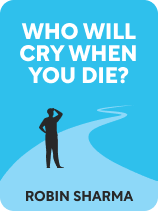

This article is an excerpt from the Shortform book guide to "Who Will Cry When You Die?" by Robin Sharma. Shortform has the world's best summaries and analyses of books you should be reading.
Like this article? Sign up for a free trial here .
What does it mean to live every day to the fullest? Is it possible to live a full life without taking any risks?
People often throw around the phrase “live your life to the fullest” as if it’s something straightforward and simple, but it’s easier said than done. In his book Who Will Cry When You Die?, Robin Sharma makes this advice actionable by providing five tips on how to make each day count.
Here is Sharma’s advice on how to live life to the fullest.
What It Means to Live Life Fully
According to Robin Sharma, living each day to the fullest means imbuing every moment with intention and significance even when you’re not actively pursuing your purpose. For instance, if you’re watching a movie with your partner, you may not be actively pursuing your purpose of becoming a concert pianist. However, you can still make this a meaningful experience by connecting with your partner.
You don’t have to start grand, world-changing projects, like founding a charity, to live fully, assures Sharma. You actually live most fully in the small moments—like in a supermarket queue. Rather than scrolling through social media, strike up a conversation with someone in line or notice a baby smiling at you. Use the moment to form connections or find joy.
| Other Ways to Live Fully Sharma defines a full life as one in which you make every moment—especially the small moments—meaningful and intentional. Others, though, think you live most fully when you invest in strong relationships. In the 83-year old Harvard Study of Adult Development, findings showed that social connections, more than anything else, were predictive of personal happiness and health—two attributes you can view as synonymous with “living fully.” And it’s not the number of relationships a person has but rather the relationships’ quality that leads to greater happiness and longer-lasting health. Rather than making every moment in your life matter, therefore, you might solely make your relationships more meaningful. |
Strategy #1: Live Each Day Like a Micro-Version of Your Life
To live every day to the fullest, Sharma advises you to view each day as if it were a micro-version of your whole life. If the way you live today reflected the way you live your entire life, what would you do with your 24 hours? Would you mindlessly chase after success or devote time to family and community?
(Shortform note: Sharma’s advice to live every day as if it were a micro-version of your life may not work for everyone. Due to factors outside of your control—poor health, bad weather, emergencies, and so on—it’s simply not possible to live every day as you would want to live your entire life. Further, this approach can create guilt and anxiety when you have a sub-par day. An alternative, less stressful approach is to check in with yourself periodically to make sure you’re generally living in a way that’s reflective of what you want your life to look like.)
Strategy #2: Cherish Your Life
To soak up the most of life, Sharma suggests actively cherishing life and the moments of beauty in it. Take active joy when you see a lovely flower, for instance, to make the moment more impactful.
(Shortform note: Sharma recommends cherishing your life by finding joy wherever you can. You can also actively create situations that provide joy, by, for instance, striking up conversations with strangers, donating to a charity, or exercising regularly.)
Strategy #3: Take Risks and Seek Adventure
Sharma feels that you live a full life by taking risks and seeking adventure. He doesn’t think this means acting carelessly or always gaining from risks. Instead, he believes that when you’re habitually adventurous, you experience more of life and avoid regret. For instance, someone who regularly attends speed-dating events may not find a partner but will go on more dates than someone who won’t take that risk.
| Taking Better Risks You may struggle to follow Sharma’s advice to take more risks and be more adventurous if you’re naturally risk-averse. While you can’t eradicate your risk aversion, you can hone your risk-taking skills so that, moving forward, you take risks with less fear: 1. Practice with low-risk and low-pressure decisions. Take the risk of purchasing a new toothpaste brand, for instance. 2. Create a pros and cons list and weigh them against each other. 3. Don’t fixate on the worst-case scenario. This may stymie you, and the worst-case scenario is unlikely to occur. 4 Think like someone else. Limit your natural risk aversion by adopting a persona when making decisions. Approach decisions as a world-famous rock star, for instance. |
To Take Risks and Seek Adventure, You May Need to Change the Way You Think
To take more risks and seek out adventure, you may need to alter the way you think, writes Sharma. This is because your thoughts dictate what you can accomplish in life. If you think you’re a capable person, you’ll be a capable person. If you fixate on your limitations, however, you’ll likely never be able to surpass them, warns Sharma.
If you believe, for instance, that you can play sports, you’ll take the risk of trying out for a team, which will expand the scope and joy of your life. If you believe you’re terrible at sports, though, you’ll never take that risk. Your life becomes smaller, and you’ll live it less fully.
(Shortform note: Sharma isn’t the first self-help author to discuss the impact your thoughts have on your life’s trajectory and scope. Napoleon Hill’s Think and Grow Rich covers this at length in the context of achieving personal success: If you want to be successful, writes Hill, think only about the possibility of success, never about the possibility of failure. Hill is more dogged than Sharma in his insistence on a success mindset, however, pushing the reader to pursue and think about their purpose and route to success in every waking moment, while Sharma makes room for non-purpose-aligned activities.)
Strategy #4: Build an Environment That Reflects the World You Want to Live In
Sharma says to live fully, surround yourself with people and things that reflect the life you want to have. This is because your environment shapes your thoughts, and your thoughts, as just discussed, shape your world and the way you live in it. For instance, beautify your office, subscribe to a new streaming service, or take a class to meet like-minded people.
(Shortform note: As Sharma suggests, your environment profoundly impacts your mental state and in particular your mental health. For instance, a dark space can exacerbate depression, and living in a high-crime neighborhood can worsen anxiety. If you’d benefit from a change in your environment, approach upgrades from five angles: aesthetics, sensory input, people, culture and values, and familiarity (the degree to which you feel comfortable in a space). Tackle improvements from one angle at a time.)
Strategy #5: Be Resiliently Yourself
To make the most of all your existence has to offer, move through life in your own way, insists Sharma. Lead the lifestyle you want, consume the media you like, and talk about the things you’re interested in. If you constantly do things you don’t genuinely want to do, adds Sharma, you won’t get as much out of life.
If, for instance, your friends are having kids, don’t feel compelled to start a family yourself simply because others are. If you have kids because you feel you should, parenthood probably won’t be fulfilling.
(Shortform note: Sharma recommends always being yourself, advice expanded upon by Brené Brown in her book The Gifts of Imperfection. Brown advocates for always showing your most authentic self to the world, but goes a step further to discuss the obstacles to authenticity. You may fear resistance from loved ones if you become more authentic, for instance. To overcome this fear, recognize that though there may be pain involved in learning to live authentically, it’ll be more painful to live inauthentically, writes Brown.)

———End of Preview———
Like what you just read? Read the rest of the world's best book summary and analysis of Robin Sharma's "Who Will Cry When You Die?" at Shortform .
Here's what you'll find in our full Who Will Cry When You Die? summary :
- Why most people end up leading lives they’ll regret
- How to seize control of your life and turn it into one you’ll look back on fondly
- How and why you should set intentional breaks in your daily life






